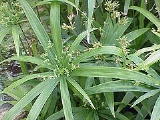
Cyperus
Overview
Cyperus is a large genus
of about 600 species
of sedge
s, distributed throughout all continents in both tropical and temperate regions. They are annual
or perennial plants, mostly aquatic
and growing in still or slow-moving water up to 0.5 m deep. The species vary greatly in size, with small species only 5 cm tall, while others can reach 5 m in height. Common names include papyrus sedges, flatsedges, nutsedges, umbrella-sedges and galingales.
The stems are circular in cross-section in some, triangular in others, usually leafless for most of their length, with the slender grass
-like leaves at the base of the plant, and in a whorl at the apex of the flowering stems. The flower
s are greenish, and wind pollinated
; they are produced in clusters among the apical leaves.
Genus
In biology, a genus is a low-level taxonomic rank used in the biological classification of living and fossil organisms, which is an example of definition by genus and differentia...
of about 600 species
Species
In biology, a species is one of the basic units of biological classification and a taxonomic rank. A species is often defined as a group of organisms capable of interbreeding and producing fertile offspring. While in many cases this definition is adequate, more precise or differing measures are...
of sedge
Cyperaceae
Cyperaceae are a family of monocotyledonous graminoid flowering plants known as sedges, which superficially resemble grasses or rushes. The family is large, with some 5,500 species described in about 109 genera. These species are widely distributed, with the centers of diversity for the group...
s, distributed throughout all continents in both tropical and temperate regions. They are annual
Annual plant
An annual plant is a plant that usually germinates, flowers, and dies in a year or season. True annuals will only live longer than a year if they are prevented from setting seed...
or perennial plants, mostly aquatic
Aquatic ecosystem
An aquatic ecosystem is an ecosystem in a body of water. Communities of organisms that are dependent on each other and on their environment live in aquatic ecosystems. The two main types of aquatic ecosystems are marine ecosystems and freshwater ecosystems....
and growing in still or slow-moving water up to 0.5 m deep. The species vary greatly in size, with small species only 5 cm tall, while others can reach 5 m in height. Common names include papyrus sedges, flatsedges, nutsedges, umbrella-sedges and galingales.
The stems are circular in cross-section in some, triangular in others, usually leafless for most of their length, with the slender grass
Poaceae
The Poaceae is a large and nearly ubiquitous family of flowering plants. Members of this family are commonly called grasses, although the term "grass" is also applied to plants that are not in the Poaceae lineage, including the rushes and sedges...
-like leaves at the base of the plant, and in a whorl at the apex of the flowering stems. The flower
Flower
A flower, sometimes known as a bloom or blossom, is the reproductive structure found in flowering plants . The biological function of a flower is to effect reproduction, usually by providing a mechanism for the union of sperm with eggs...
s are greenish, and wind pollinated
Anemophily
Anemophily or wind pollination is a form of pollination whereby pollen is distributed by wind. Anemophilous plants may be either gymnosperms or angiosperms ....
; they are produced in clusters among the apical leaves.
Unanswered Questions

